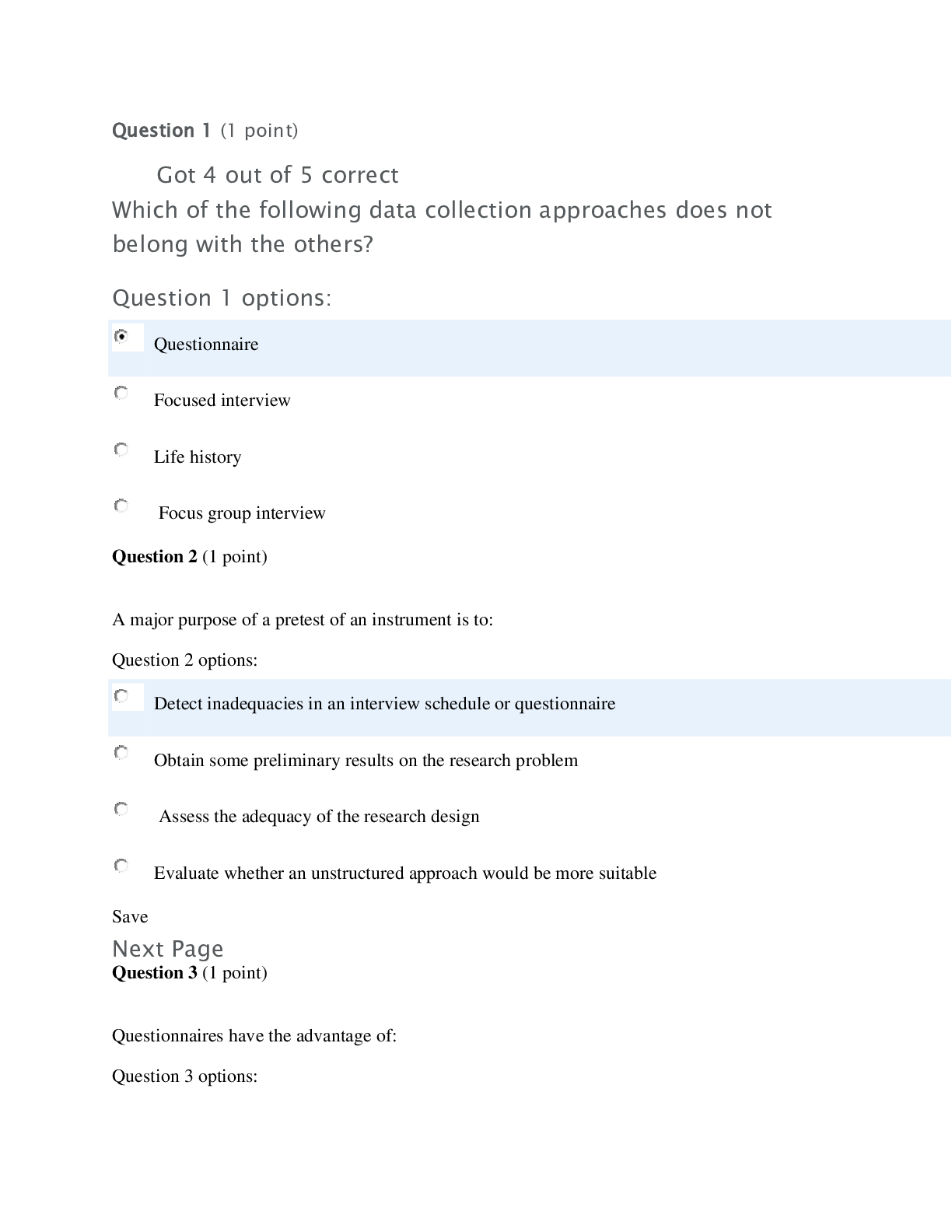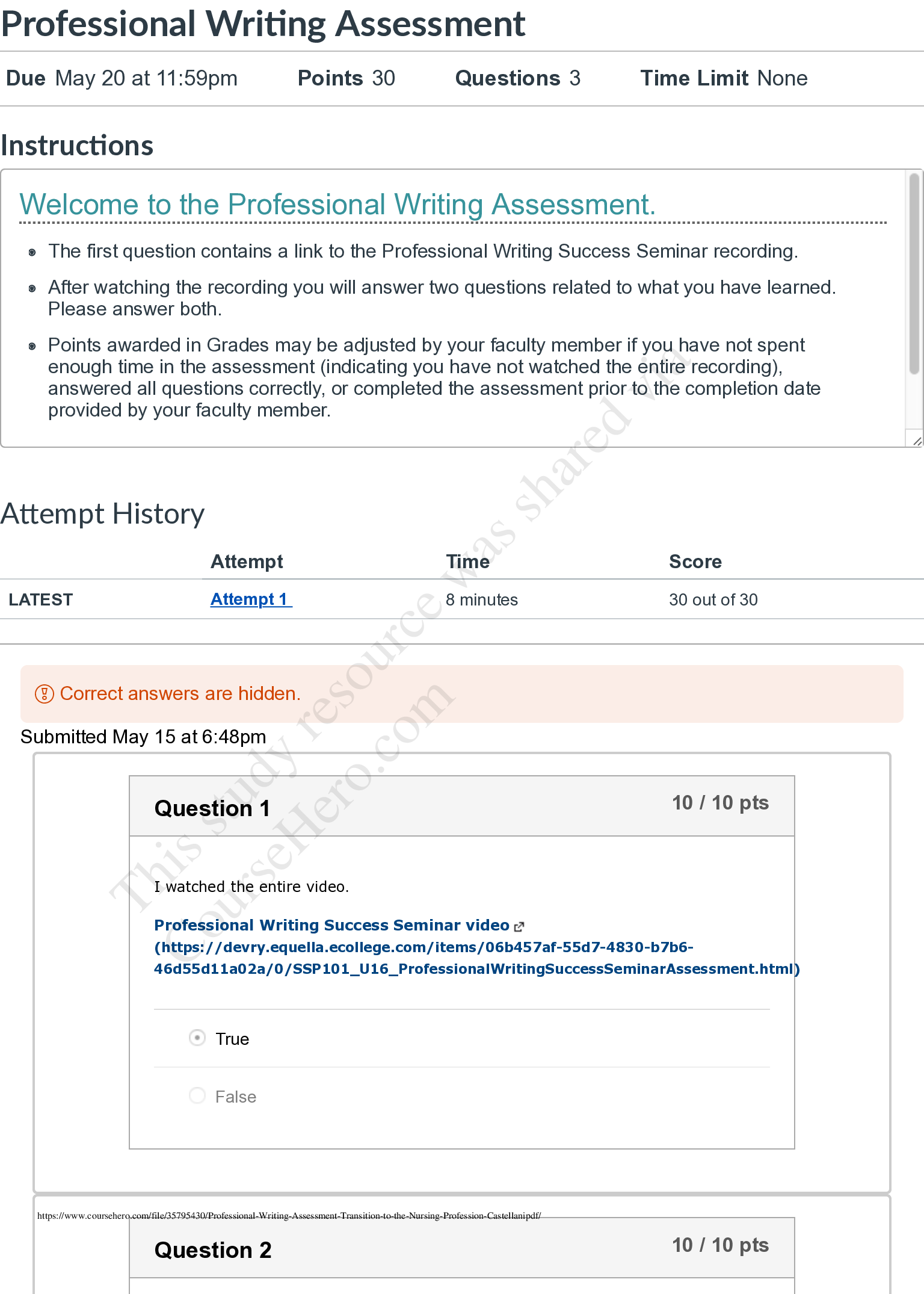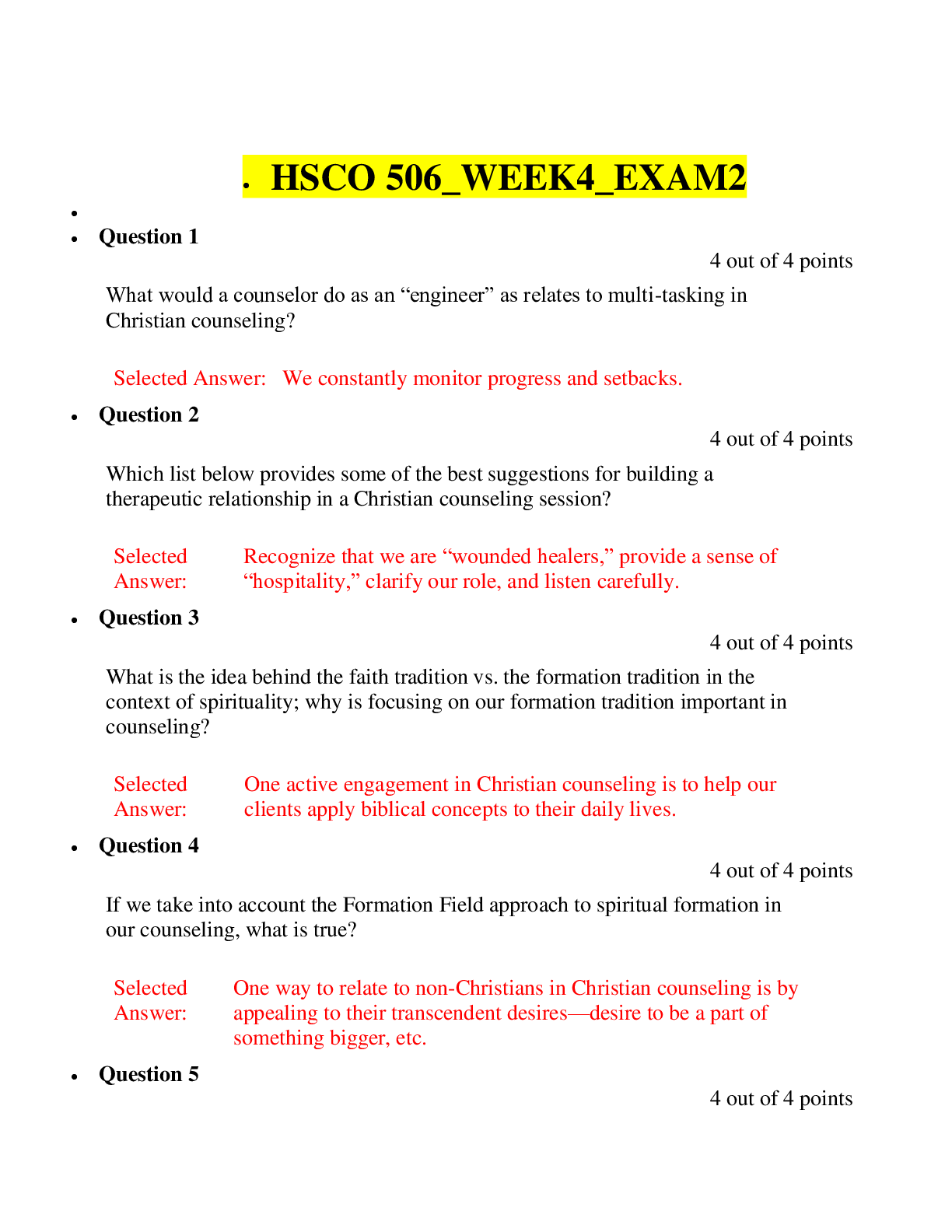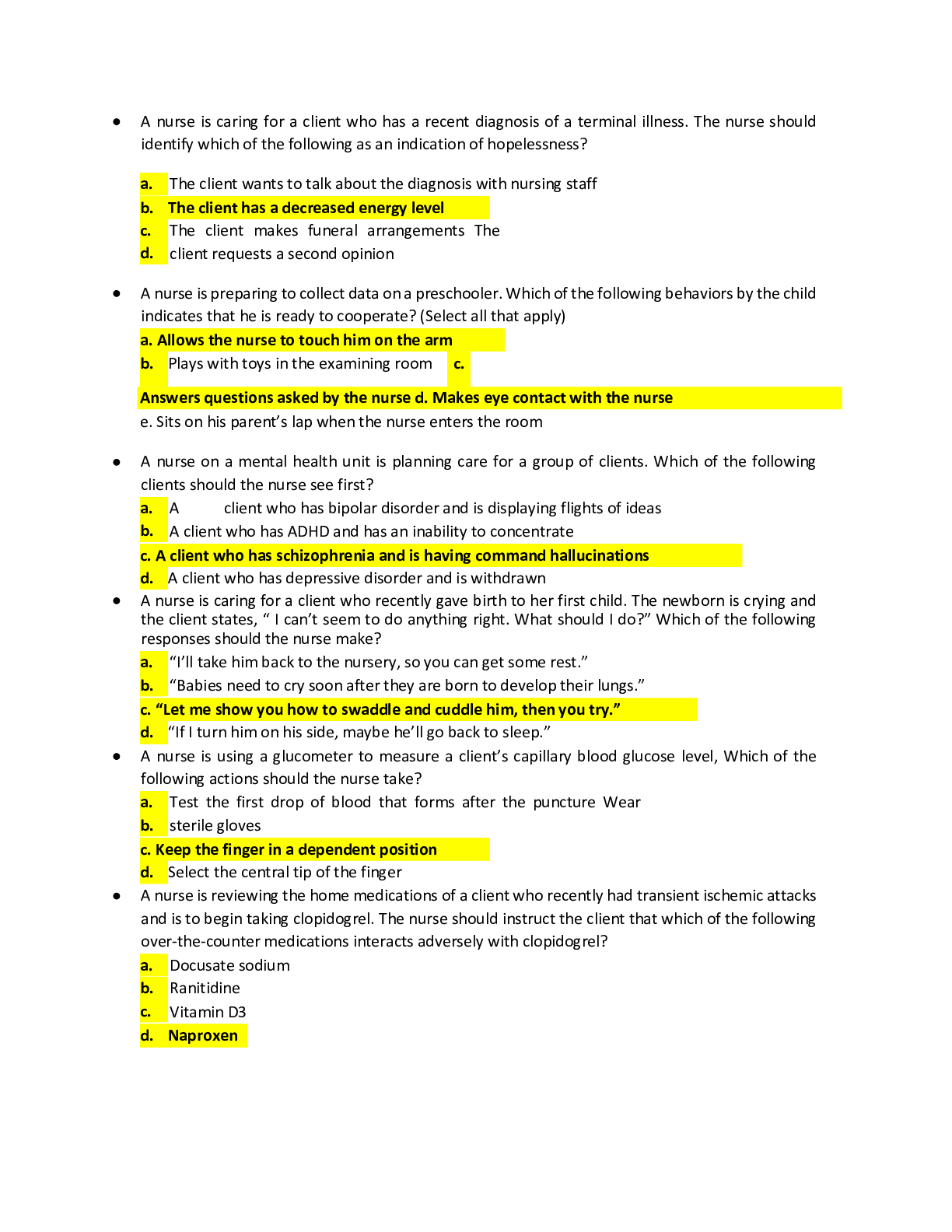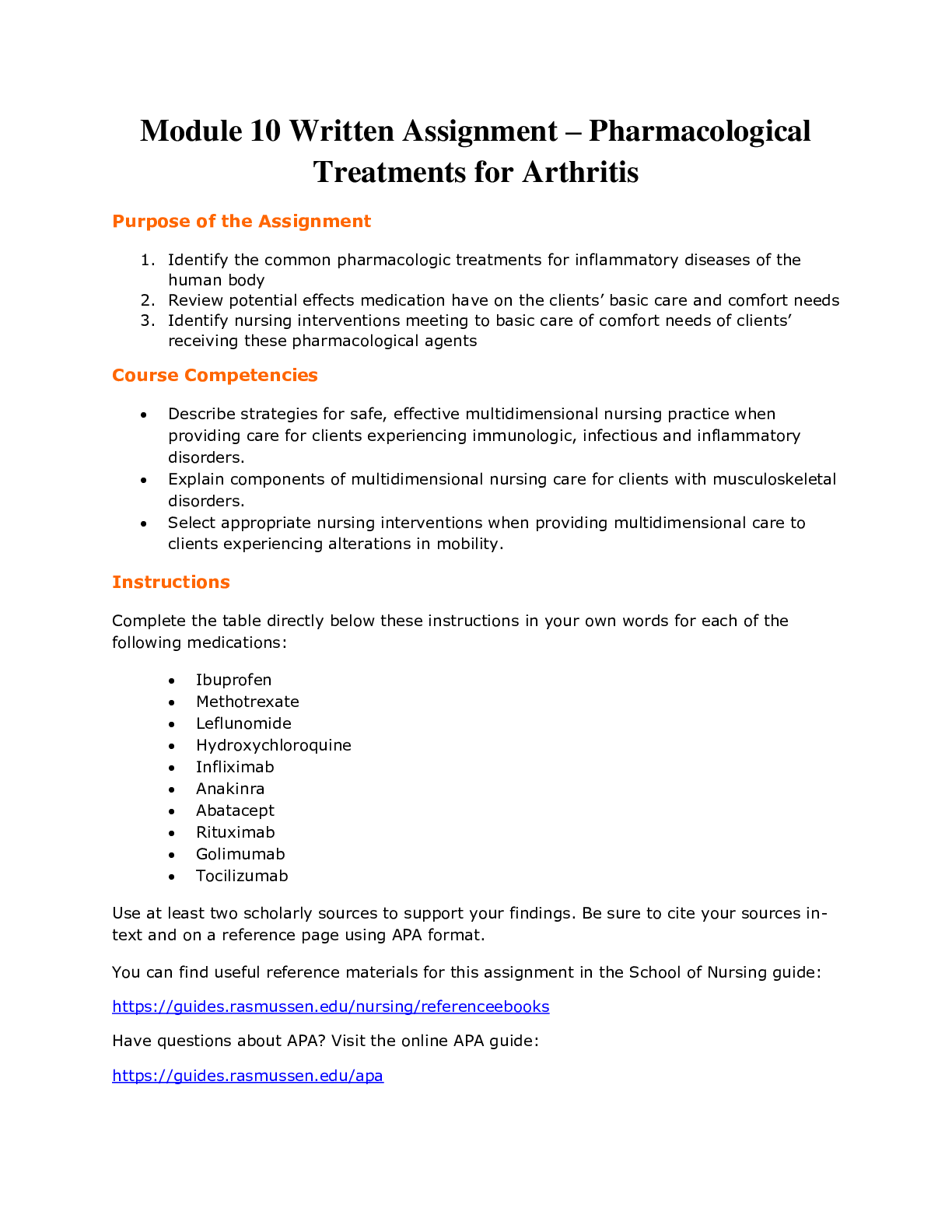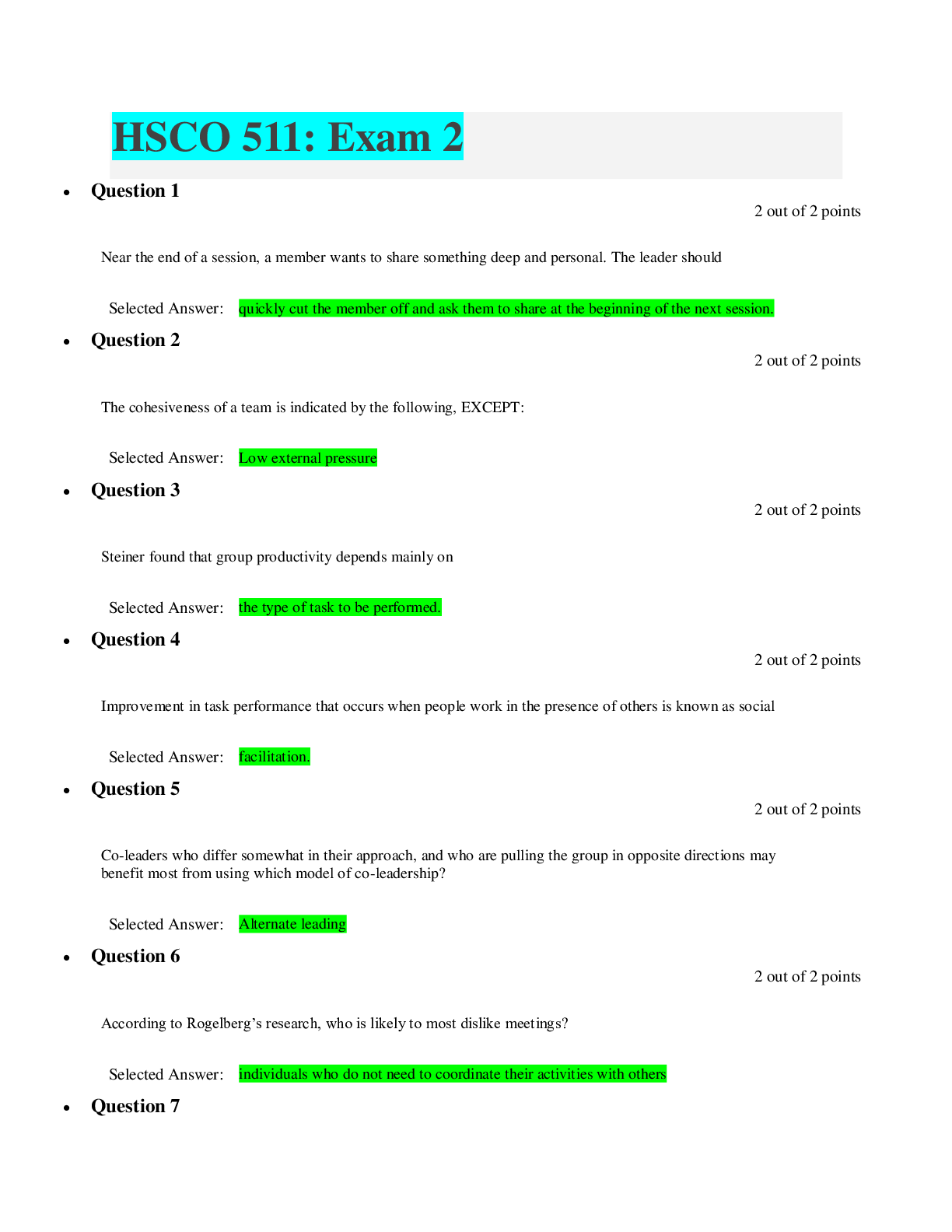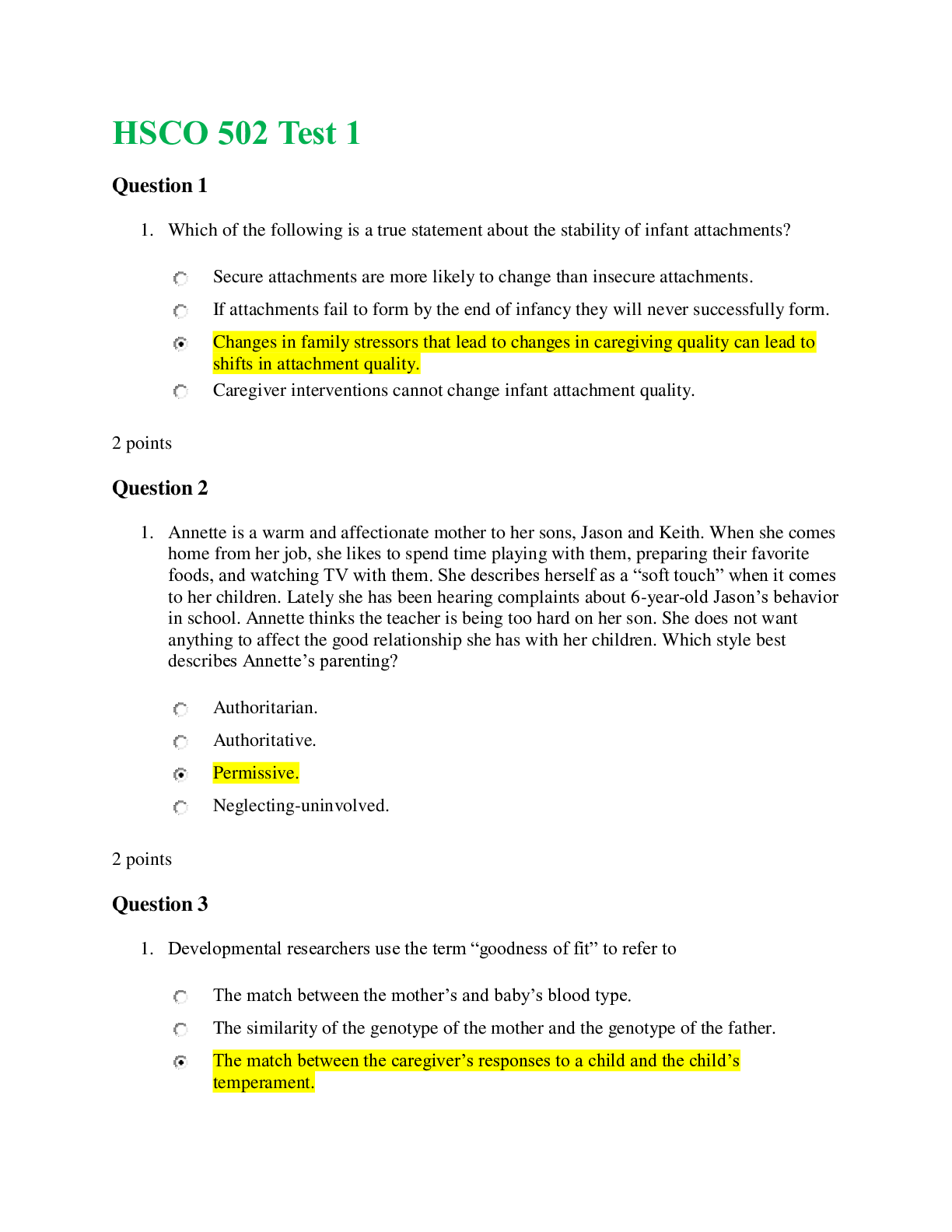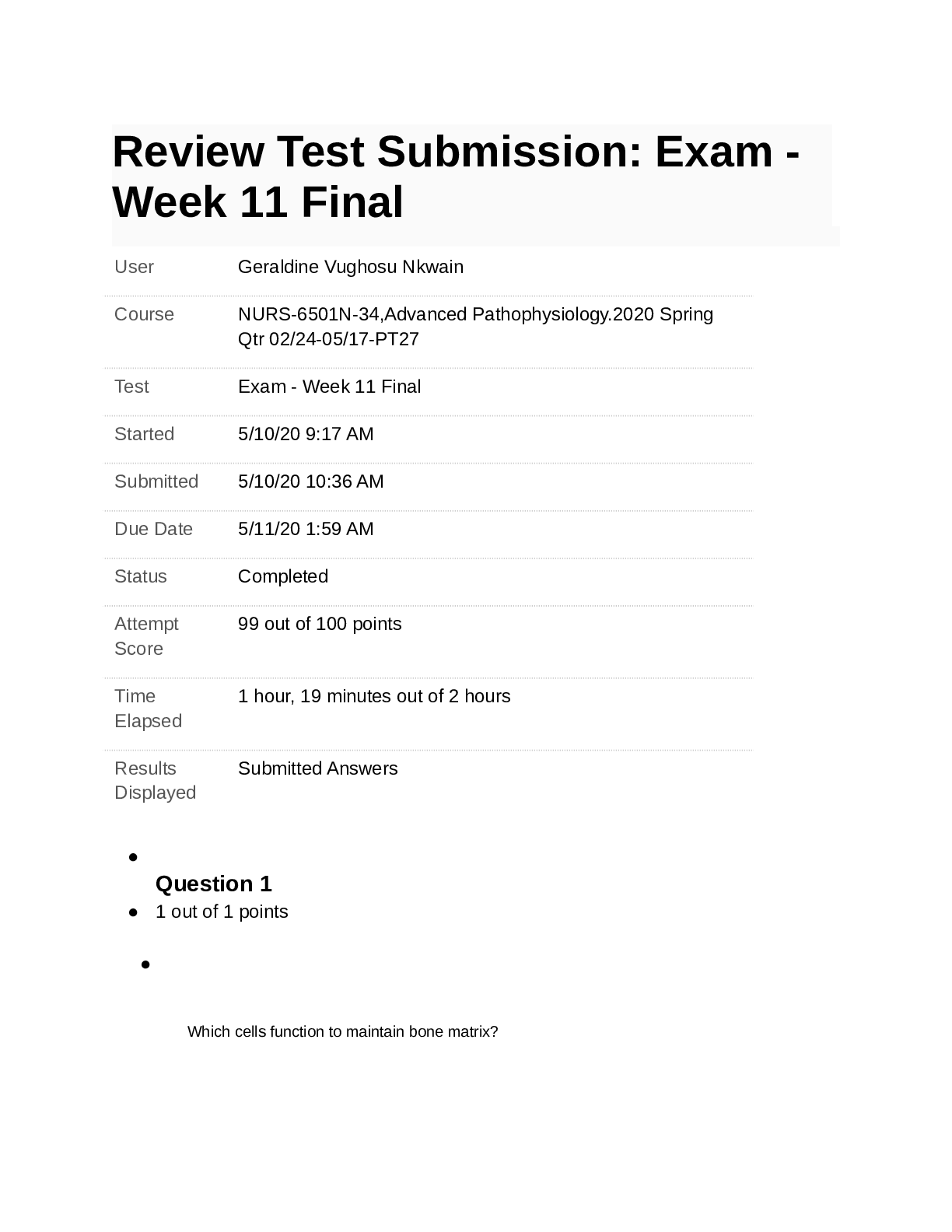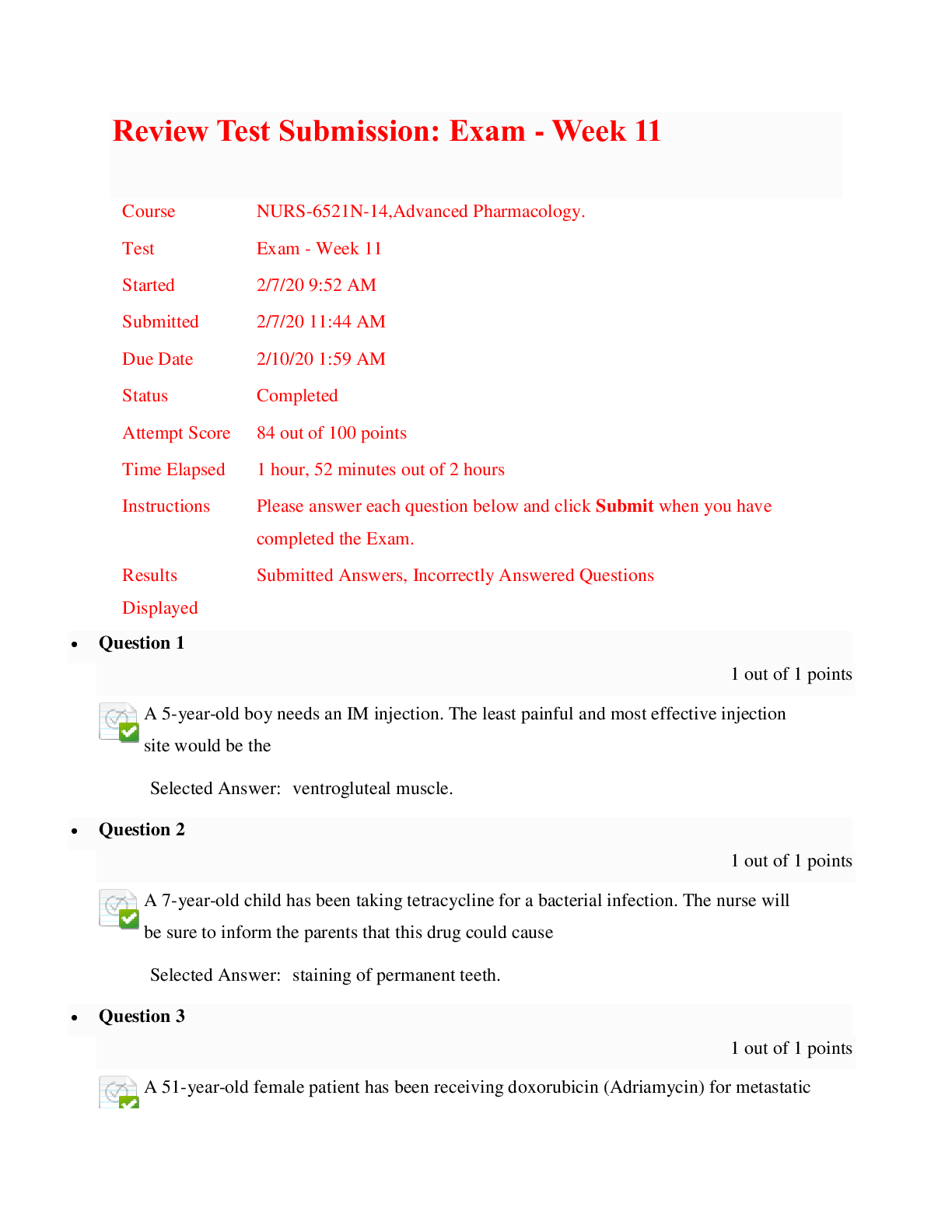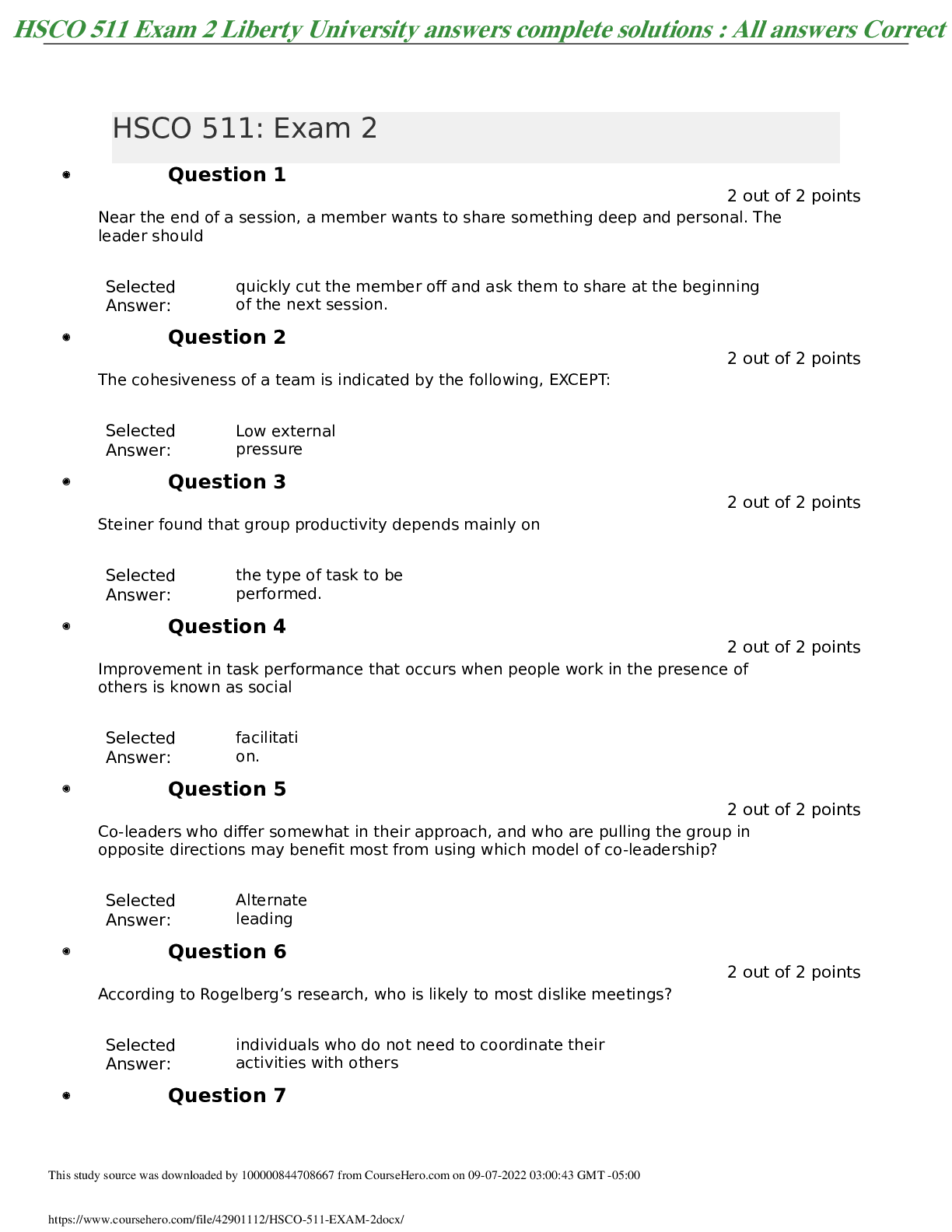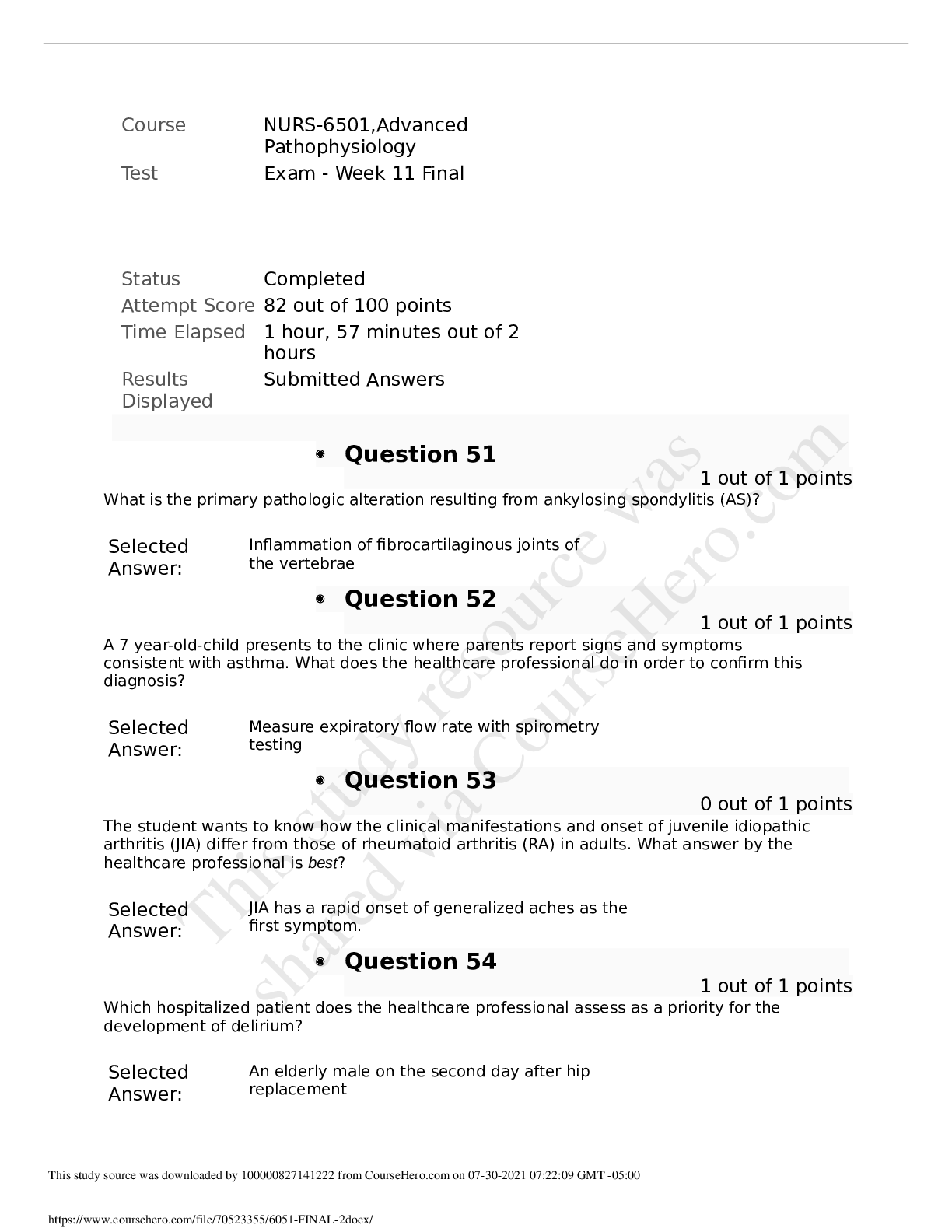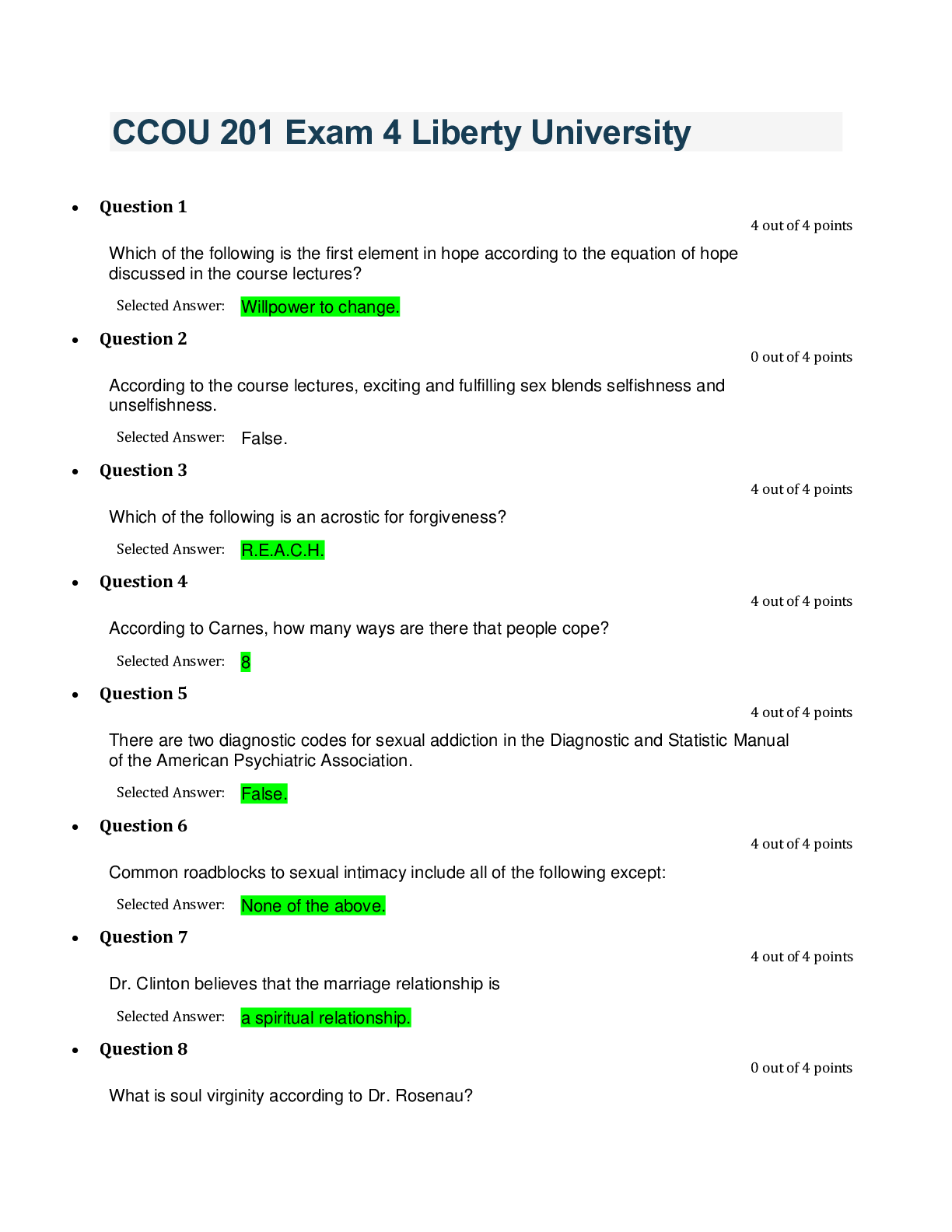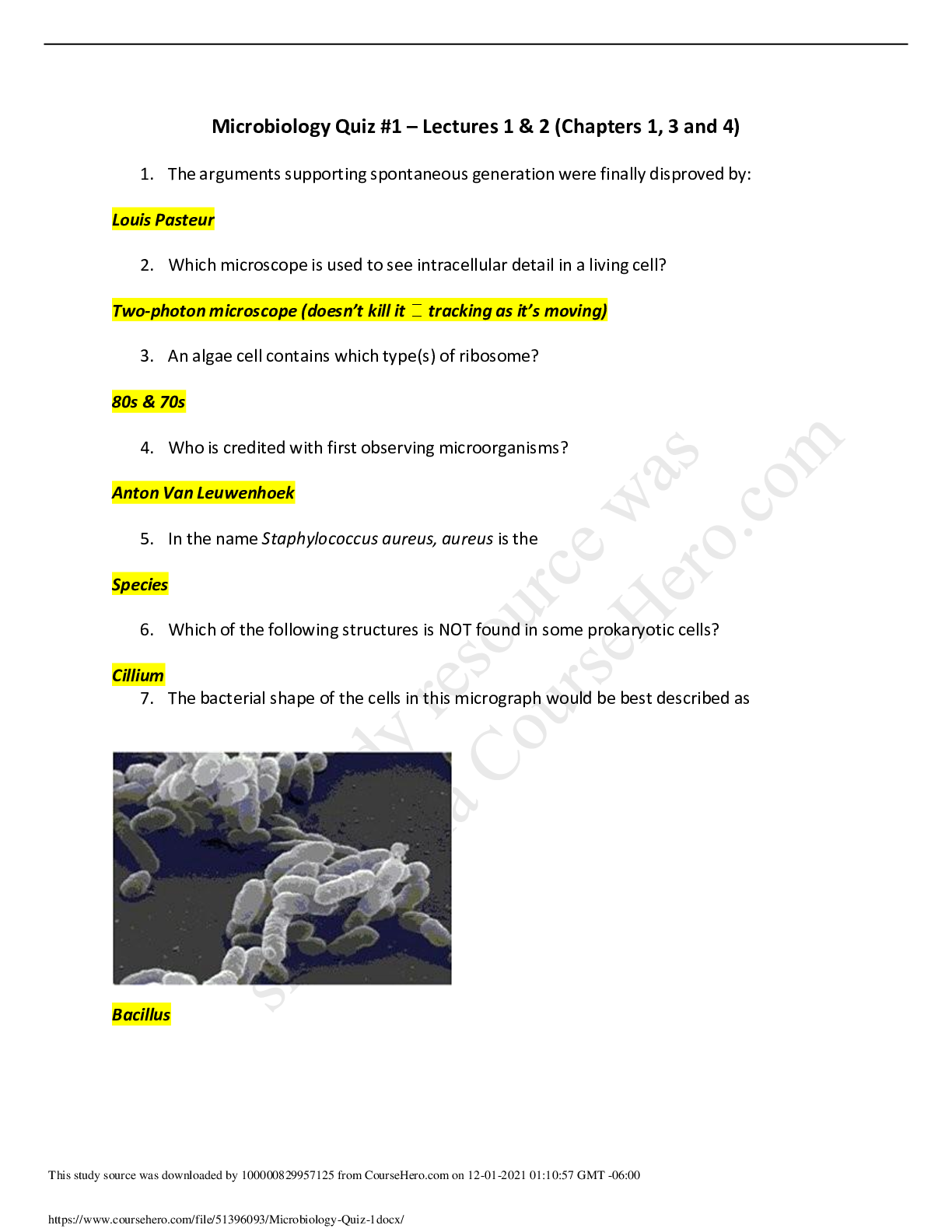Health Care > EXAM > HSCO 502 test 3: (Version 2) Latest , Liberty University answers complete solutions, Attempt Score 9 (All)
HSCO 502 test 3: (Version 2) Latest , Liberty University answers complete solutions, Attempt Score 96 Out of 100 Points
Document Content and Description Below
HSCO 502 TEST 3 Question 1 1. In a study of relationship satisfaction and stability over a 3-year period, which of the following types of partnerships was the most likely to break up? Anxious man with... anxious woman. Avoidant man with secure woman. Anxious man with avoidant woman. Avoidant man with ambivalent woman. 2 points Question 2 1. Which of these is the best definition of relativistic thought according to Perry? Every person has a right to his or her own opinion and we should not question each other. People relate to each other because everyone is in search of absolute truth. Relativistic thinking is a stage that supersedes the ability to see inherent contradictions. Weighing evidence and considers ideas and values more objectively. 2 points Question 3 1. Research on job satisfaction indicates which of the following? Job satisfaction is more closely related to monetary compensation than to any other variable. Job satisfaction is most closely related to sociability, with sociable individuals more likely to be satisfied with any job. Personal style and job characteristics are important ingredients in job satisfaction. Job satisfaction actually has nothing to do with how well personality characteristics match the demands of the job. 2 points Question 4 1. Based upon research about marital relationships conducted by Gottman, what feature of a relationship best predicts the demise of a relationship? Homeostatic steady state. Negative affect reciprocity. Disillusionment. Childlessness. 2 points Question 5 1. In self-determination theory, which of the following is considered one of the basic psychological needs that motivates our adaptation or coping efforts at any age? Autonomy. Optimization. Avoidance. Generativity. 2 points Question 6 1. Measures of subjective well-being typically assess degree of felt happiness or positive emotion know as hedonic well-being. Other measures of well-being focus more on assessing feelings of purpose, growth and master which is sometimes called Self-determination Psychological well-being Eudaemonic well-being. Expressive well-being. 2 points Question 7 1. Which of the following individuals would most likely be in the reorganizational stage according to Schaie’s view of adult adjustment? A 20-year-old carpenter’s apprentice. A 25-year-old single mother. A 45-year-old businessman. A 62-year-old truck driver. 2 points Question 8 1. The “Big Five” personality traits are Conscientiousness, agreeableness, aggressiveness, neuroticism and introversion. Warmth, neuroticism, conscientiousness, introversion and extroversion. Sociability, openness, neuroticism, agreeableness and aggressiveness. Agreeableness, neuroticism, openness, extraversion and conscientiousness. 2 points Question 9 1. How do sociologists classify actions like entry into marriage and becoming a parent? As social constructions. As dualistic decisions. As adult rituals. As marker events 2 points Question 10 1. Reitzes and Mutran suggest Several factors at preretirement are strong predictors of positive attitudes toward retirement later, including religiosity. feeling confident in relationships with friends. number of close relatives, especially children. mandatory retirement age. 2 points Question 11 1. Kindling-behavioral sensitization describes A process of shaping behavior to desired outcomes. A process of increasing sensitivity to stressful triggers. A process that explains how neurobiological factors interact with chemicals in the brain. The measure of total life stresses. 2 points Question 12 1. In late adulthood, many of the physical losses of middle adulthood (e.g., sensory decline) continue. For people over 65 there is also a new physical problem that about half of the population must contend with, called osteoarthritis. diabetes. multi-infarct dementia. Alzheimer’s disease. 2 points Question 13 1. Video response. Review the video on, page 481 of your book; from the 3 statements select which one(s) are correct. Statement 1: John stated three changes relevant to middle age; physical ability declines, mental abilities are still intake, and there are some sexual changes for men, but not to the extent that women experience. Statement 2: John stated that he has experience significant decline in his physical abilities, his ability to be successful as an adult student, and has encountered erectile dysfunction. Statement 3: a. John’s commentary on middle age demonstrates the concept of regulation of loss, representing an adaption of expectations. Statements 1, 2, and 3 are correct. Statement 1 is correct Statement 2 is correct Statements 1 and 3 are correct. 2 points Question 14 1. Which of the following is the most important factor in helping young adults avoid a slide into poverty? Education. Religion. Family size. Avoiding delinquency. 2 points Question 15 1. Video response. Review the video on, page 411 of your book; from the 3 statements select which one(s) are correct. Statement 1: the video demonstrates Gary’s conflict between returning to a previous status of relying on his parents while in graduate school and the obligation he feels to be independent and care for his family. Statement 2: Gary feels like his success thus far is attributed to the values that his parent exemplified and reflects their support and expectations for him. Statement 3: Gary is an example of the failure to launch syndrome and is comfortable relying on his parents for support while in graduate school. Statement 1 is correct. Statement 2 is correct Statement 1 and 2 are correct Statement 3 is correct. 2 points Question 16 1. Which of the following is the most likely physical change that most adults will experience in their 40s ? For many, it will take longer for eyes to adapt to changes in light than before. Many will acquire a serious disability. For most people the ability to hear normal speech sounds will noticeably decline. For most people their body will produce more elastin as they age. 2 points Question 17 1. How do the attitudes toward death among elderly people compare to the attitudes of younger age groups? Elderly people report more anxiety about death than middle-aged adults. Elderly people report less anxiety about death than middle-aged adults. Elderly people are less realistic about its inevitability than middle-aged adults are. There are no differences between the elderly and other age groups in regard to attitudes toward death. 2 points Question 18 1. According to Erikson’s theory, which developmental task is central to the middle adulthood stage of life? Ego integrity. Intimacy. Autonomy. Generativity. 2 points Question 19 1. Which statement regarding the research findings of partner selection is NOT accurate. Secure individuals tend to be paired more often with other secure individuals. Research suggests that having a secure individual in the partnership will automatically improve the quality of the relationship. The most rare paring is between avoidant-avoidant and anxious -anxious persons. Insecure individuals need someone that can confirm their expectations of close relationshipsl 2 points Question 20 1. Gender differences in career choice are influenced by gender-role beliefs and life style preferences including this notion The gender-role beliefs of males and females have not changed in the last 40 years. Women today more often choosing to be full time homemakers. Women still give greater priority to their role as caregiver, and men still give greater priority to their role as breadwinner. Men now share equally in housework and child care. 2 points Question 21 1. In Super’s developmental approach to career satisfaction, he argues that an individual’s vocational self-concept evolves over time. What is the career development stage that usually characterizes adolescents and young adults? The growth stage. The establishment stage. The exploratory stage. The maintenance stage. 2 points Question 22 1. High concentrations of ______________ secreted by cells of the immune system are related to maladaptive inflammation. Aiatheses. Cytokines. Neurotransmitters. Endorphins. 2 points Question 23 1. Which statement is CORRECT regarding the attchment prototypes in peer/romatic tradition: Anxious-ambivalent types find that others are reluctant to get as close as they would like to. Secure types are uncomfortable depending on others. Avoidant types are surprisingly more comfortable being intimate than other types. Secure types maintain strict boundaries aod not let others get to close to them. 2 points Question 24 1. Which of the following are aspects of palliative care? Pain management and emotional care. Life-sustaining treatments. Nursing-centered care. Physician-assisted suicide. 2 points Question 25 1. The extent to which a person experiences nervousness, fear, anger, sadness, contempt, and guilt is called Kindling-sensitization. Behavioral inhibition. Negative affectivity. Negative heritability. 2 points Question 26 1. Video response. Review the video on, page 457 of your book; from the 3 statements select which one(s) are correct. Statement 1: The video demonstrates how MaKonnen used his physical fitness degree in various roles after graduation. Statement 2: The video demonstrates how MaKonnen uses his business marketing degree in his current job but much differently than he had anticipated as a college student. Statement 3: the video demonstrates how Makonnen realized that he was not going to be a professional football player and had to use his degree and talents to find employment and a way that challenged his career path. Statement 1 is correct. Statement 2 is correct Statement 2&3 are correct Statement 3 is correct. 2 points Question 27 1. Fluid intelligence is to ____________ as crystallized intelligence is to ____________. Working memory / metacognition. Pragmatics / mechanics. Metacognition / working memory. Mechanics / pragmatics. 2 points Question 28 1. Studies of brain activity during the early adult years suggest an increased capacity for moral behavior. perceptual acuity. sexual activity. behavioral and emotional control. 2 points Question 29 1. When a parent is classified as “dismissive” tend to have babies that are Secure. Anxious. Disorganized. Avoidant. 2 points Question 30 1. Which of the following has not been proposed as a reason why people seek meaning in their lives? CORRECT IS #D Establishing meaning helps people feel like they have control. Establishing meaning helps people define their values, morals, and ethics. Establishing meaning helps people feel self-worth. Establishing meaning helps people feel like they are better than other people. 0 points Question 31 1. What can you reliably predict about normal age-related changes in cognitive functioning in middle adulthood? Most people will have difficulty remembering events in their past life. Most people will have difficulty paying attention to work tasks. Most people need to take a little more time when solving complex problems. Most people become more impulsive when it comes to decision-making. 2 points Question 32 1. Which of the following is not one of Kitchener’s stages of thinking dimensions: Certainity of knowledge. Processes use to acquire knowledge. Evidence used to justify one’s judgement. Drawing meaningful conclusions. 2 points Question 33 1. Video response. Review the video on, page 503 of your book; from the 3 statements select which one(s) are correct. Statement 1: Pam had limited awareness of how significant Laurel was being affected immediately after the divorce and did not respond to her daughter’s issues. Statement 2: One of the main contributions to Laurels post-divorce problems are her feeling like she had lost control. Statement 3: Pam made a wise choice to overcompensate for the separation anxiety and control issues that Laurel was having by setting very few boundaries. Statement 1 is correct. Statements 1 and 2 are correct Statements 2 and 3 are correct Statement 3 is correct. 2 points Question 34 1. Which of the following is not one of the dimensions that Kitchener used to differentiate the stages of reflective judgment? The age of the individual. The level of certainty about the knowledge that the individual manifests. The kinds of processes the individual uses to acquire knowledge. The kinds of evidence the individual uses to justify conclusions. 2 points Question 35 1. Video response. Review the video on, page 559 of your book; from the 3 statements select which one(s) are correct. Statement 1: Alvin stated that the most difficult part of having Alzheimer’s disease was having to tell his children and grandchildren. Statement 2: Alvin’s friend Jan recognized that he went from being very organized to misplacing things. Statement 3: One issues with Alvin’s disease is he often loses personal items. Statements 1, 2, and 3 are correct. Statement 1 is correct Statements 2 and 3 are correct Statement 3 is correct. 2 points Question 36 1. The two types of stress management presented by Lazarus and Folkman are Problem-focused and emotion-focused. One-dimensional and two-dimensional. Management and reduction. Sensitizing and blunting. 2 points Question 37 1. Which of the following descriptions best characterizes the timing of indicators of adulthood in people’s lives today? People show some indicators of adult status at earlier ages today while other indicators of adulthood are more delayed. People generally show indicators of adult status at earlier ages today than they did in earlier decades. People show all indicators of adult status at later ages today than they did in earlier decades. There are no differences in the timing of adulthood today compared to earlier decades. 2 points Question 38 1. Petersen and Steward found that the characteristics related to high levels of generativity in adolescents and young adults are: Extraversion and agreeableness. Agreeableness and openness. Affiliation and power needs. Introversion and agreeableness. 2 points Question 39 1. The happiest people have excellent social relationships. This is because social relationships are an important source of stress. happy people are more likely to successfully make friends. they delude themselves into believing they are happy and that others like them. neurotic people are generally more happy. 2 points Question 40 1. According to research by Baltes and associates, in which decade is wisdom acquistion most important? After 75. From 65 to 75 From 55 to 65. From 15 to 25. 2 points Question 41 1. Which of the following does NOT contribute to social segregation for the elderly? CORRECT #D Being a member of a cohort with a different set of cultural experiences than younger cohorts. Retirement. Death of friends, partners and relatives. Decreased ability for physical activities. 0 points Question 42 1. When considering primary and second control strategies, which statement is FALSE: 60-year-olds are more flexible in adjusting goals than a 20-year-old. Our secondary and primary control strategies decrease with age unitl late midlife. In old age, our secondary control control strategies increase. Autonomy, competence are related to primary control. 2 points Question 43 1. Arnett’s research suggests that young adults today believe that adulthood is primarily defined By the timing of achievements, such as marriage and parenthood. On the basis of reaching a certain age. Accepting responsibility for consequences of one’s on actions and making independent decisions. on the basis of more judgments of psychological independence. 0 points Question 44 1. A positive emotional style Is a trait inherited by only some individuals. Soly depends upon environmental circumstances. Can be cultivated by everyone. Is a characteristic that is genetic and can not be learned. 2 points Question 45 1. Video response. Review the video on, page 569 of your book; from the 3 statements select which one(s) are correct. Statement 1: Thelma uses the concept of selection in deciding what activities she will participate in, in order to maintain her health and wellness. Statement 2: Thelma and her sister downsized from a large home, to a retirement community as a way of optimizing their environment to match their life stage and desires. Statement 3: Thelma is not able to compensate for the restraints her age places on her physical abilities. Statements 1 is correct. Statement 2 is correct Statements 1 and 2 are correct Statement 3 is correct. 2 points Question 46 1. Which of the following assumptions is NOT indicative of the life span development model? Development is impacted by the interplay of heredity and environment. Cultural influences are more important in adult development than child development. Development across the life span is primarily a process of unfolding maturation. From birth to death, adapation continues. 2 points Question 47 1. Cross-cultural research findings indicate that Age-related changes in personality traits differ across different cultural groups. Age-related changes in personality traits are consistent across different cultural groups. Age-graded changes in personality traits do not exist in more collectivistic cultures. Age-graded changes in personality traits do not exist in more individualistic cultures. 2 points Question 48 1. “The reminiscence bump” refers to CORRECT #B the large number of stereotypes about older people rambling on about their lives. the large number of autobiographical memories that are retained from the late adolescent through early adult period. the large number of autobiographical memories that are retained from the most recent past, even for elderly people. the increase in medical expenses experienced by most people after age 65. 0 points Question 49 1. In Ryan and Deci’s self-determination theory, the fundamental psychological needs they described include Autonomy. Adequate shelter. Freedom from fear. Generativity. 2 points Question 50 1. King and Kitchener offer specific suggesions for those that work with emerging adults. Which of the following is NOT one of their recommedations: Teach young adults to examine the assumptions that they use for decision making for poorly defined problems. Teach the process of information gathering, evaluating, and drawing conclusions. Allow permissive boundaries that faciliate open exploration. d.Create a supportive environment that promotes reflective thinking [Show More]
Last updated: 1 year ago
Preview 1 out of 26 pages
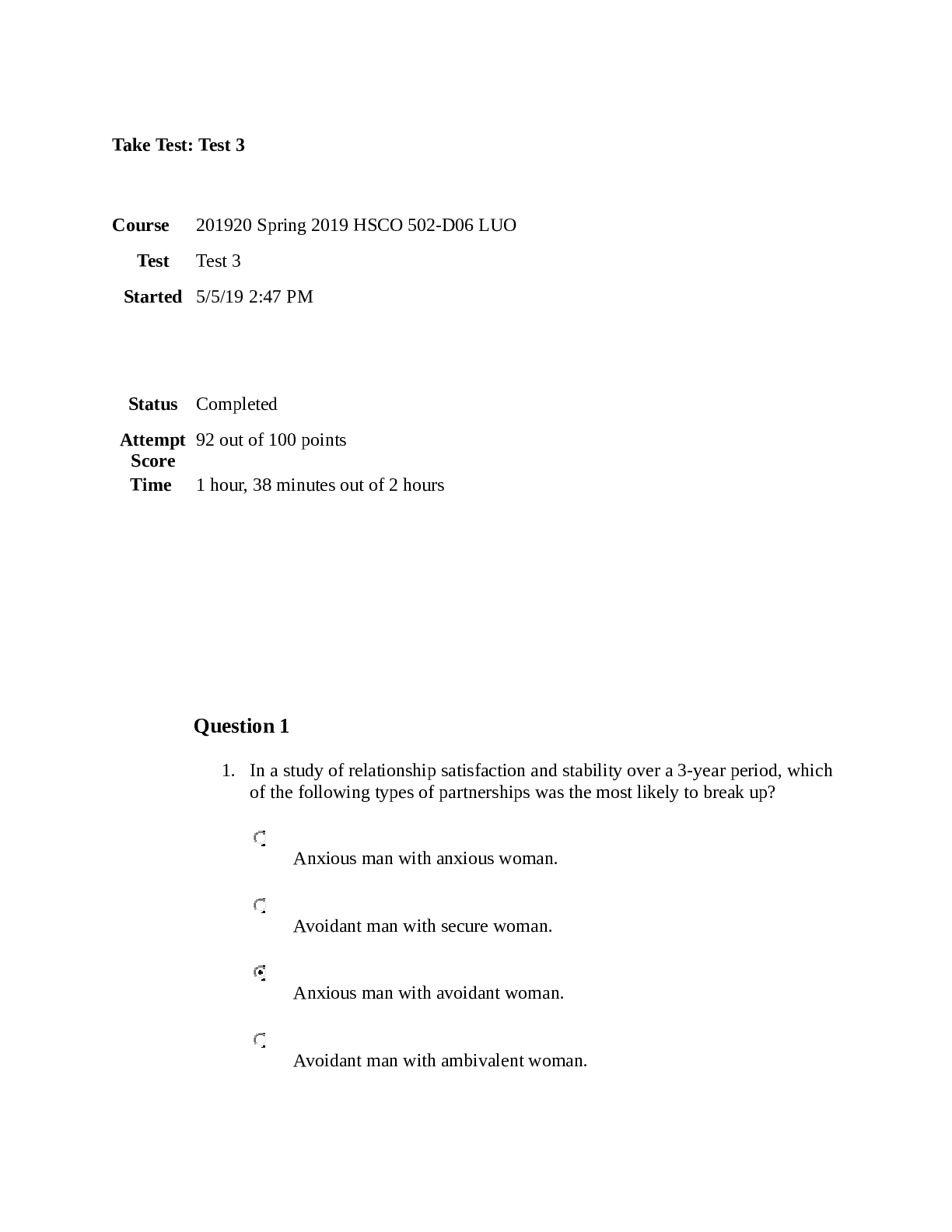
Reviews( 0 )
Document information
Connected school, study & course
About the document
Uploaded On
Mar 13, 2021
Number of pages
26
Written in
Additional information
This document has been written for:
Uploaded
Mar 13, 2021
Downloads
0
Views
46





.png)


